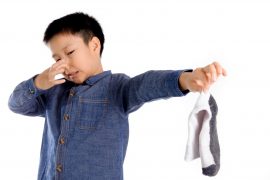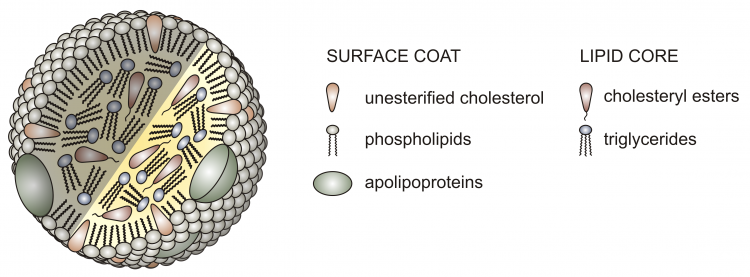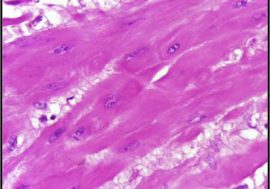0:39 | Cholesterol & ApoB in Cardiac Risk
5:48 | How Oxytocin Works
9:49 | Sponsored by HAPS
10:11 | Smell Affects Cortisol / Stress
14:38 | Sponsored by AAA
14:52 | Featured topic 2: Big Ideas - Essential Concepts in A&P
If you cannot see or activate the audio player click here.
Questions & Feedback: 1-833-LION-DEN (1-833-546-6336)
Follow The A&P Professor on Twitter, Facebook, Blogger, Nuzzel, Tumblr, or Instagram!
The big ideas are usually simple ideas. (David Ogilvy)
1 | Cholesterol & ApoB in Cardiac Risk
5 minutesApolipoprotein B (ApoB) is the protein part of the lipoprotein particles in our bloodstream that contain cholesterol. In primary medical care, we often measure total low-density lipoprotein (LDL) or non-high-density lipoprotein (non-HDL) to help us determine risk for cardiovascular disease. As protocols are reviewed, some believe measuring ApoB is a better measure of cardiovascular risk.
- Is is time to retire cholesterol tests? (news article in Science) my-ap.us/2AEN4sw
- Apo B Test (summary of the Apo B blood test) my-ap.us/2AGg7fm
2 | How Oxytocin Works
4 minutesWe know oxytocin (OT) promotes labor contractions of the uterine myometrium. But how? New evidences helps explain the mechanism.
- Oxytocin can regulate myometrial smooth muscle excitability by inhibiting the Na+‐activated K+ channel, Slo2.1 (research article from The Journal of Physiology) my-ap.us/2AJsDLf
3 | Sponsored by HAPS
0.5 minutesThe Human Anatomy & Physiology Society (HAPS) is a sponsor of this podcast. Did you know there's a one-day regional HAPS conference in March? Check it out. You can help appreciate their support by clicking the link below and checking out the many resources and benefits found there.
Anatomy & Physiology Society
theAPprofessor.org/haps

4 | Smell Affects Cortisol / Stress
4.5 minutesSmells in our environment can increase or decrease blood cortisol levels, indicating modulation of our stress response. In particular, the smell of a romantic partner can reduce a woman's stress. Hmmm. Might it also reduce test anxiety? Interesting...
- Why Sniffing Your Partner's Shirt Helps Reduce Stress (brief article summarizing the research) my-ap.us/2AKT8Qf
- Stressed out? Try smelling your partner’s shirt (another brief article) my-ap.us/2ACl60D
- Olfactory cues from romantic partners and strangers influence women’s responses to stress. (the original research article) my-ap.us/2ALcBAl
- Helping Students With Test Anxiety | TAPP Episode 32 | Bonus

5 | Sponsored by AAA
0.5 minute
The searchable transcript for this episode, as well as the captioned audiogram of this episode, are sponsored by The American Association of Anatomists (AAA) at anatomy.org
6 | Big Ideas - Essential Concepts in A&P
11.5 minutesWhen telling the story of human structure & function, we want our students to identify the "big ideas" and even just the "kinda big ideas," as well as both the "main characters" and "minor characters." By making a habit of looking for the kinda big ideas, perhaps running a concept list to collect them, students may begin to understand the essential concepts of A&P. And it may help them see the connectness of the structures and functions of the body.
- Running Concept Lists Help Students Make Connections | TAPP Episode 8
- Storytelling is the Heart of Teaching A&P | TAPP Episode 12
- The Core Concepts of Physiology: A New Paradigm for Teaching Physiology
- by Joel Michael , William Cliff, Jenny McFarland, Harold Modell, Ann Wright
- Book details:
- Published on behalf of APS The American Physiological Society by Springer
- APS members: my-ap.us/APSCoreConceptsBook
- Bookstore: amzn.to/2GJd2Rb
- 15 core concepts of physiology
- Explanations and applications of a concept-based approach to the physiology course
- Concepts:
- Evolution
- Homeostasis
- Causality
- Energy
- Structure/function
- Cell theory
- Levels of organization
- Cell–cell communication
- Cell membrane
- Flow down gradients
- Genes to proteins
- Interdependence
- Mass balance
- Physics/chemistry
- Scientific reasoning

If the hyperlinks here are not active, go to TAPPradio.org to find the episode page.
- More details at the episode page.
- Transcript available at the script page.
- Listen to any episode on your Alexa device.
- Join The A&P Professor social network:
- Blog
- Twitter @theAPprofessor
- Facebook theAPprofessor
- Instagram theAPprofessor
- YouTube
Amazon referrals help defray podcasting expenses.
Transcript and captions for this episode are supported by the American Association of Anatomists.anatomy.org
The Human Anatomy & Physiology Societyalso provides support for this podcast. theAPprofessor.org/haps
(Clicking on sponsor links helps let them know you appreciatetheir support of this podcast!)
Click here to listen to this episode—or access the detailed notes and transcript.



No comments:
Post a Comment